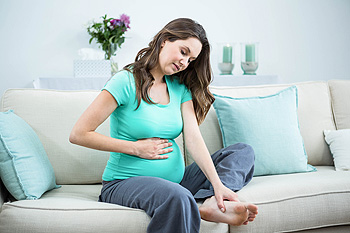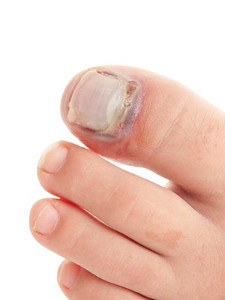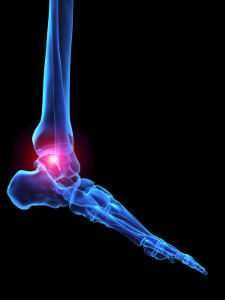Items filtered by date: April 2018
Why Are My Feet Swollen During My Pregnancy?
 Pregnancy can create certain health conditions, and this may be apparent in the feet. Hormonal changes can be responsible for softening ligaments in the body, and the feet are often affected. Becoming flat-footed may be a result of these changes, in addition to shoes increasing in size. The feet must endure the additional weight that develops; any may contribute to the onset of heel pain. The feet may swell, which is a result of excess fluids in the body. This can possibly be managed by limiting the amount of time standing. Additionally, it is important to drink plenty of fresh water daily, and this will help to flush out some of the fluid that has accumulated in the feet. If heel pain due to pregnancy has affected your daily routine, please consider consulting with a podiatrist.
Pregnancy can create certain health conditions, and this may be apparent in the feet. Hormonal changes can be responsible for softening ligaments in the body, and the feet are often affected. Becoming flat-footed may be a result of these changes, in addition to shoes increasing in size. The feet must endure the additional weight that develops; any may contribute to the onset of heel pain. The feet may swell, which is a result of excess fluids in the body. This can possibly be managed by limiting the amount of time standing. Additionally, it is important to drink plenty of fresh water daily, and this will help to flush out some of the fluid that has accumulated in the feet. If heel pain due to pregnancy has affected your daily routine, please consider consulting with a podiatrist.
Pregnant women with swollen feet can be treated with a variety of different methods that are readily available. For more information about other cures for swollen feet during pregnancy, consult with Dr. Paul Drucker from NYC Foot Care, PC. Our doctor will attend to all of your foot and ankle needs.
What Foot Problems Can Arise During Pregnancy?
One problem that can occur is overpronation, which occurs when the arch of the foot flattens and tends to roll inward. This can cause pain and discomfort in your heels while you’re walking or even just standing up, trying to support your baby.
Another problem is edema, or swelling in the extremities. This often affects the feet during pregnancy but tends to occur in the later stages.
How Can I Keep My Feet Healthy During Pregnancy?
- Wearing orthotics can provide extra support for the feet and help distribute weight evenly
- Minimize the amount of time spent walking barefoot
- Wear shoes with good arch support
- Wear shoes that allow for good circulation to the feet
- Elevate feet if you experience swelling
- Massage your feet
- Get regular, light exercise, such as walking, to promote blood circulation to the feet
If you have any questions please feel free to contact our offices located in 70th Street Manhattan, 60th Street Manhattan, Jamaica, Queens, Plainview, NY and Fair Lawn, NJ . We offer the newest diagnostic and treatment technologies for all your foot and ankle needs.
Symptoms of a Broken Toe
 If you’ve dropped something heavy on your toe, and you begin to notice swelling and bruising, you may have what is referred to as a broken toe. Severe pain typically accompanies this injury, and walking may prove to be a difficult task to accomplish. If you stubbed your toe with extreme force, the toe will appear to be misaligned if the break is severe. Experiencing a broken toe can be easily managed as long as the skin is not broken or the toe is not out of alignment. This often includes resting and elevating your foot to attain relief. There may be symptoms that appear to accompany more serious fractures including numbness, the toe turning blue, and coldness when touched. It’s suggested to consult with a podiatrist for additional information and proper treatment options for a broken toe.
If you’ve dropped something heavy on your toe, and you begin to notice swelling and bruising, you may have what is referred to as a broken toe. Severe pain typically accompanies this injury, and walking may prove to be a difficult task to accomplish. If you stubbed your toe with extreme force, the toe will appear to be misaligned if the break is severe. Experiencing a broken toe can be easily managed as long as the skin is not broken or the toe is not out of alignment. This often includes resting and elevating your foot to attain relief. There may be symptoms that appear to accompany more serious fractures including numbness, the toe turning blue, and coldness when touched. It’s suggested to consult with a podiatrist for additional information and proper treatment options for a broken toe.
A broken toe can be very painful and lead to complications if not properly fixed. If you have any concerns about your feet, contact Dr. Paul Drucker from NYC Foot Care, PC. Our doctor will treat your foot and ankle needs.
What to Know About a Broken Toe
Although most people try to avoid foot trauma such as banging, stubbing, or dropping heavy objects on their feet, the unfortunate fact is that it is a common occurrence. Given the fact that toes are positioned in front of the feet, they typically sustain the brunt of such trauma. When trauma occurs to a toe, the result can be a painful break (fracture).
Symptoms of a Broken Toe
- Throbbing pain
- Swelling
- Bruising on the skin and toenail
- The inability to move the toe
- Toe appears crooked or disfigured
- Tingling or numbness in the toe
Generally, it is best to stay off of the injured toe with the affected foot elevated.
Severe toe fractures may be treated with a splint, cast, and in some cases, minor surgery. Due to its position and the pressure it endures with daily activity, future complications can occur if the big toe is not properly treated.
If you have any questions please feel free to contact our offices located in 70th Street Manhattan, 60th Street Manhattan, Jamaica, Queens, Plainview, NY and Fair Lawn, NJ . We offer the newest diagnostic and treatment technologies for all your foot and ankle needs.
Symptoms of Rheumatoid Arthritis
 If you are experiencing swelling, pain and stiffness in the toes, you may have what is referred to as rheumatoid arthritis. The toes are consistently bent in a downward position, making it difficult to walk. Additionally, it’s common for bunions to develop, which is a small bony protrusion on the side of the big toe. Many people endure pain in the entire foot, and will often notice the nails have become separated from the nail bed. In the desire to obtain relief the gait is often altered affecting the ball of the foot. Recent research has shown that it may be beneficial to wear shoes that provide adequate room for the toes to move about freely, in addition to avoid wearing high heels. There are several ways to treat this condition depending on the extent of the damage that has been incurred. If you are afflicted with this condition it’s suggested to schedule a consultation with a podiatrist to determine the severity of this ailment, and discuss the best treatments options available.
If you are experiencing swelling, pain and stiffness in the toes, you may have what is referred to as rheumatoid arthritis. The toes are consistently bent in a downward position, making it difficult to walk. Additionally, it’s common for bunions to develop, which is a small bony protrusion on the side of the big toe. Many people endure pain in the entire foot, and will often notice the nails have become separated from the nail bed. In the desire to obtain relief the gait is often altered affecting the ball of the foot. Recent research has shown that it may be beneficial to wear shoes that provide adequate room for the toes to move about freely, in addition to avoid wearing high heels. There are several ways to treat this condition depending on the extent of the damage that has been incurred. If you are afflicted with this condition it’s suggested to schedule a consultation with a podiatrist to determine the severity of this ailment, and discuss the best treatments options available.
Because RA affects more than just your joints, including the joints in your feet and ankles, it is important to seek early diagnosis from your podiatrist if you feel like the pain in your feet might be caused by RA. For more information, contact Dr. Paul Drucker of NYC Foot Care, PC. Our doctor will assist you with all of your podiatric concerns.
What Is Rheumatoid Arthritis?
Rheumatoid Arthritis (RA) is an autoimmune disorder in which the body’s own immune system attacks the membranes surrounding the joints. Inflammation of the lining and eventually the destruction of the joint’s cartilage and bone occur, causing severe pain and immobility.
Rheumatoid Arthritis of the Feet
Although RA usually attacks multiple bones and joints throughout the entire body, almost 90 percent of cases result in pain in the foot or ankle area.
Symptoms
- Swelling and pain in the feet
- Stiffness in the feet
- Pain on the ball or sole of feet
- Joint shift and deformation
Diagnosis
Quick diagnosis of RA in the feet is important so that the podiatrist can treat the area effectively. Your doctor will ask you about your medical history, occupation, and lifestyle to determine the origin of the condition. Rheumatoid Factor tests help to determine if someone is affected by the disease.
If you have any questions please feel free to contact our offices located in 70th Street Manhattan, 60th Street Manhattan, Jamaica, Queens, Plainview, NY and Fair Lawn, NJ . We offer the newest diagnostic and treatment technologies for all your foot and ankle needs.
